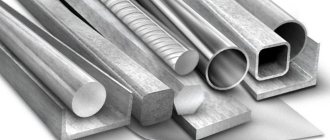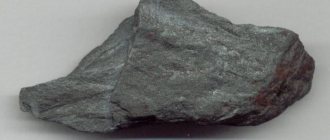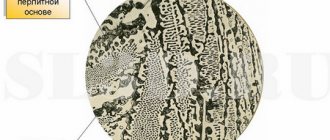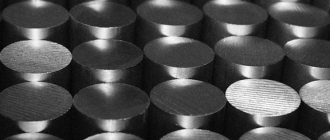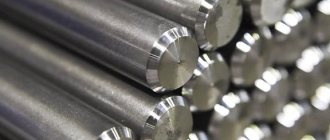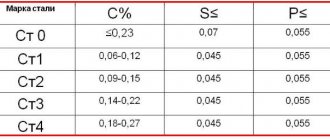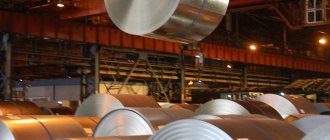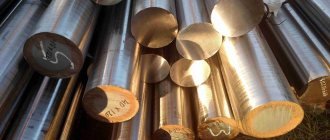Understanding such an issue as the classification of carbon steels is very important, as this allows you to get a complete understanding of the characteristics of one or another type of this popular material. The marking of such steels, like any other, is no less important, and a specialist must be able to understand it in order to choose the right alloy in accordance with its properties and chemical composition.
A huge range of rolled metal products are produced from carbon steels
Compound
Depending on the amount of carbon, carbon and alloy steel are divided. The presence of carbon gives the material strength and hardness, and also reduces viscosity and ductility. Its content in the alloy is up to 2.14%, and the minimum amount of impurities due to the manufacturing process allows the bulk to consist of iron up to 99.5%.
High strength and hardness are what characterize carbon steel.
Impurities that are constantly included in the structure of carbon steel have a small content. Manganese and silicon do not exceed 1%, and sulfur and phosphorus are within 0.1%. An increase in the amount of impurities is characteristic of another type of steel, which is called alloyed.
The lack of technical ability to completely remove impurities from the finished alloy allows the following elements to be included in carbon steel:
- hydrogen;
- nitrogen;
- oxygen;
- silicon;
- manganese;
- phosphorus;
- sulfur
The presence of these substances is determined by the steel melting method: converter, open-hearth or other. And carbon is added on purpose. If the amount of impurities is difficult to regulate, then adjusting the level of carbon in the composition of the future alloy affects the properties of the finished product. When the material is filled with carbon up to 2.4%, steel is classified as carbon.
Classification by degree of deoxidation
The division of carbon steels into various types is influenced, among other things, by such a parameter as the degree of deoxidation. Depending on this parameter, carbon steel alloys are divided into calm, semi-calm and boiling.
Quiet steels have a more homogeneous internal structure, the deoxidation of which is carried out by adding ferrosilicon, ferromanganese and aluminum to the molten metal. Due to the fact that the alloys of this category were completely deoxidized in the furnace, their composition does not contain ferrous oxide. Residual aluminum, which inhibits grain growth, gives such steels a fine-grained structure. The combination of a fine-grained structure and the almost complete absence of dissolved gases allows the formation of high-quality metal from which the most critical parts and structures can be made. Along with all their advantages, carbon steel alloys of the quiet category also have one significant drawback - their smelting is quite expensive.
The structure of a steel ingot depends on the degree of deoxidation of the steel
Cheaper, but also of lower quality, are boiling carbon alloys, the smelting of which uses a minimum amount of special additives. In the internal structure of such steel, due to the fact that the process of its deoxidation in the furnace was not completed, there are dissolved gases that negatively affect the characteristics of the metal. Thus, the nitrogen contained in such steels has a bad effect on their weldability, provoking the formation of cracks in the weld area. The developed segregation in the structure of these steel alloys leads to the fact that the rolled metal that is made from them has heterogeneity both in its structure and in its mechanical characteristics.
Semi-quiet steels occupy an intermediate position both in their properties and in the degree of deoxidation. Before pouring into molds, a small amount of deoxidizing agents is introduced into their composition, due to which the metal hardens practically without boiling, but the process of gas evolution in it continues. As a result, a casting is formed, the structure of which contains fewer gas bubbles than in boiling steels. Such internal pores are almost completely welded during the subsequent rolling of the metal. Most semi-mild carbon steels are used as structural materials.
You can familiarize yourself with all GOST requirements for carbon steel by downloading this document in pdf format from the link below.
Download GOST 380-2005 Carbon steel of ordinary quality. Stamps
Characteristic
The characteristics and structure of the metal are changed using heat treatment, through which the required surface hardness or other requirements for the use of the steel structure are achieved. However, not all structural properties can be adjusted using thermal methods. Such structurally insensitive characteristics include rigidity, expressed by the elastic modulus or shear modulus. This is taken into account when designing critical components and mechanisms in various fields of mechanical engineering.
In cases where the calculation of the strength of an assembly requires the use of small-sized parts that can withstand the required load, heat treatment is used. This effect on “raw” steel makes it possible to increase the rigidity of the material by 2-3 times. The metal that is subjected to this process is subject to requirements regarding the amount of carbon and other impurities. This steel is called high quality.
Types of heat treatment
Carbon steels, the use of which is possible almost everywhere where a person carries out his life activities, are capable of significantly changing their mechanical properties. To do this, heat treatment must be performed, the meaning of which is to change the structure of the steel during heating, holding and subsequent cooling based on a special regime.
There are the following types of temperature treatment:
- Annealing – reduces hardness and refines grains, increases workability, viscosity and plasticity, reduces internal stresses, and eliminates structural inhomogeneities.
- Normalization – corrects the structure of overheated and cast steel, eliminates the network of secondary cementite in hypereutectoid steel.
- Hardening – allows you to obtain the highest hardness and strength.
- Vacation.
Classification of carbon steels
According to the direction of application of products, carbon steel is divided into tool and structural.
The last of them is used for the construction of various buildings and frame parts. Tools are used to make durable tools for performing any work, including metal cutting. The use of metal products in the household required the classification of steel into different categories with specific properties: heat-resistant, cryogenic and corrosion-resistant.
According to the method of production, carbon steels are divided into:
- electric steel;
- open hearth;
- oxygen converter.
Differences in the structure of the alloy are due to the presence of different impurities characteristic of a particular smelting method.
The relationship of steel to chemically active environments has made it possible to divide products into:
- boiling;
- semi-calm;
- calm.
Carbon content divides steel into 3 categories:
- hypereutectoid, in which the amount of carbon exceeds 0.8%;
- eutectoid, with a content of 0.8%;
- hypoeutectoid – less than 0.8%.
It is the structure that is a characteristic feature in determining the state of the metal. In hypoeutectoid steels, the structure consists of pearlite and ferrite. Eutectoid ones have pure pearlite, while hypereutectoid ones are characterized by pearlite with admixtures of secondary cementite.
By increasing the amount of carbon, steel increases strength and reduces ductility. The viscosity and brittleness of the material also have a great influence. As the percentage of carbon increases, the impact strength decreases and the fragility of the material increases. It is no coincidence that when the content is more than 2.4%, metal alloys are already classified as cast iron.
According to the amount of carbon in the alloy, steel is:
- low carbon (up to 0.29%);
- medium carbon (from 0.3 to 0.6%);
- high carbon (more than 0.6%).
Application area
As mentioned above, carbon steel alloys according to their main purpose are divided into two large categories: instrumental and structural. Tool steel alloys containing 0.65–1.32% carbon are used in full accordance with their name - for the production of tools for various purposes. In order to improve the mechanical properties of tools, they turn to such a technological operation as hardening carbon steel, which is performed without any particular difficulties.
Areas of application of carbon tool steels
Structural steel alloys are used very widely in modern industry. They are used to make parts for equipment for various purposes, structural elements for mechanical engineering and construction purposes, fasteners and much more. In particular, such a popular product as carbon wire is made from structural steel.
Carbon wire is used not only for domestic purposes, for the production of fasteners and in the construction industry, but also for the manufacture of such critical parts as springs. After carburization, structural carbon alloys can be successfully used for the production of parts that, during operation, are subject to severe surface wear and experience significant dynamic loads.
Of course, carbon steel alloys do not have many of the properties of alloy steels (in particular, stainless steel), but their characteristics are quite sufficient to ensure the quality and reliability of the parts and structures that are made from them.
Marking
When designating carbon steels of ordinary quality, the letters St are used, which are accompanied by numbers characterizing the carbon content. One digit shows the quantity multiplied by 10, and two digits by 100. When guaranteeing the mechanical composition of the alloy, B is added before the designation, and compliance with the chemical constituents is B.
At the end of the marking, two letters indicate the degree of deoxidation: ps - semi-quiet, kp - boiling state of the alloys. For calm metals this indicator is not indicated. An increased amount of manganese in the structure of the product is designated by the letter G.
When designating high-quality carbon steels used in the manufacture of tools, the letter U is used, next to which a number is written confirming the percentage of carbon in a 10-fold amount, regardless of whether it is two-digit or single-digit. To highlight higher quality alloys, the letter A is added to the designation of tool steels.
Examples of designation of carbon steels: U8, U12A, St4kp, VSt3, St2G, BSt5ps.
Chemical-thermal effect
Carbon and alloy steels can be subjected to special types of processing.
One of them is carburization, a process that is the diffusion saturation of the surface layer of steel with carbon when heated in an appropriate environment. The ultimate goal of the operation is to obtain high surface hardness and wear resistance with a tough core. Cementation can also occur in a solid carburizer, which is a mixture of charcoal and carbon dioxide salts.
Nitriding of steel is a process that involves diffusion saturation of the surface layer of steel with nitrogen. This procedure is carried out in an ammonia atmosphere at a temperature in the range of 500-700 degrees Celsius. Nitriding is carried out to obtain a surface of the part that is resistant to wear and corrosion and has great hardness.
Boriding - the top layer of steel is saturated with boron. This is done to increase wear resistance, heat resistance and hardness.
Also, to obtain heat-resistant surfaces, aluminizing is used - saturating steel with aluminum.
Production
The metallurgical industry produces metal alloys. The specificity of the process for producing carbon steel is the processing of cast iron billets with the reduction of suspended matter such as sulfur and phosphorus, as well as carbon, to the required concentration. The differences in the oxidation technique by which carbon is removed allows us to distinguish different types of smelting.
Oxygen converter method
The basis of the technique was the Bessemer method, which involves blowing air through liquid cast iron. During this process, carbon is oxidized and removed from the alloy, after which the iron ingots gradually turn into steel. The productivity of this technique is high, but sulfur and phosphorus remained in the metal. In addition, carbon steel is saturated with gases, including nitrogen. This improves strength but reduces ductility, making the steel more prone to aging and high in non-metallic elements.
Given the low quality of steel produced by the Bessemer method, it was no longer used. It was replaced by the oxygen-converter method, the difference of which is the use of pure oxygen, instead of air, when purging liquid cast iron. The use of certain technical conditions during purging significantly reduced the amount of nitrogen and other harmful impurities. As a result, carbon steel produced by the oxygen-converter method is close in quality to alloys melted in open-hearth furnaces.
The technical and economic indicators of the converter method confirm the feasibility of such smelting and make it possible to replace outdated methods of steel production.
Open hearth method
A feature of the method for producing carbon steel is the burning of carbon from cast iron alloys not only with the help of air, but also by adding iron ores and rusty metal products. This process usually takes place inside furnaces, to which heated air and combustible gas are supplied.
The size of such melting baths is very large; they can hold up to 500 tons of molten metal. The temperature in such containers is maintained at 1700 ºC, and carbon burning occurs in several stages. First, due to excess oxygen in flammable gases, and when slag forms above the molten metal, through iron oxides. When they interact, slags of phosphates and silicates are formed, which are subsequently removed and the steel acquires the required quality properties.
Steel melting in open hearth furnaces takes about 7 hours. This allows you to adjust the desired composition of the alloy when adding different ores or scrap. Carbon steel has long been manufactured using this method. Such stoves, in our time, can be found in the countries of the former Soviet Union, as well as in India.
Electrothermal method
It is possible to produce high-quality steel with a minimum content of harmful impurities by melting it in vacuum furnaces of electric arc or induction furnaces. Thanks to the improved properties of electric steel, it is possible to produce heat-resistant and tool alloys. The process of converting raw materials into carbon steel occurs in a vacuum, due to which the quality of the resulting workpieces will be higher than the previously discussed methods.
The cost of such metal processing is more expensive, so this method is used when there is a technological need for a high-quality product. To reduce the cost of the technological process, a special ladle is used, which is heated inside a vacuum container.
Production methods and quality division
Various technologies are used for the production of carbon steels, which affects their division not only by production method, but also by quality characteristics. So, they distinguish:
- high quality steel alloys;
- high-quality carbon steels;
- carbon steel alloys of ordinary quality.
Classification of carbon steels
Steel alloys of ordinary quality are smelted in open-hearth furnaces, after which they are formed into large ingots. Melting equipment used to produce such steels also includes oxygen converters. Compared to high-quality steel alloys, the steels in question may have a higher content of harmful impurities, which affects the cost of their production, as well as their characteristics.
Formed and completely solidified metal ingots are subjected to further rolling, which can be done in a hot or cold state. The hot rolling method produces shaped and sectioned products, thick and thin sheet metal, and large-width metal strips. Cold rolling produces thin sheet metal.
Modern enterprises use electric arc furnaces to produce high-quality alloys
To produce carbon steels of high-quality and high-quality categories, both converters and open-hearth furnaces, as well as more modern equipment - melting furnaces powered by electricity, can be used. The corresponding GOST imposes very stringent requirements on the chemical composition of such steels and the presence of harmful and non-metallic impurities in their structure. For example, steels classified as high-quality should contain no more than 0.04% sulfur and no more than 0.035% phosphorus. Due to the strict requirements for their production method and characteristics, high-quality and high-quality steel alloys are distinguished by increased structural purity.
Use of high-quality structural carbon steel
The scope of application is quite wide. The main consumers of alloys are the engineering and construction industries. One of the advantages is considered to be good weldability.
As the name suggests, “structural” means used for building metal structures. Another name is reinforcing steel.
Considering the main grades of quality steel used by industrial enterprises, they can be divided by purpose.
- High-quality low-carbon steels 05-10. Their main purpose is the production of responsible and high-quality structures using welding (increasing the amount of carbon helps to reduce weldability). A small amount of carbon after welding does not provoke the formation of cracks in both hot and cold conditions.
- High-quality low-carbon steels 12-20. Their main purpose is the production of structural elements and parts that are not critical, lightly loaded, and subsequently cemented. Processed by cutting, cold stamping, complex drawing. Surface requirements: wear resistance, high hardness with a soft core. We manufacture mechanical engineering elements (shaft, axle, bolt, coupling, fork, lever, flanges and others), as well as elements of boiler equipment operating at high pressure and temperatures from -40°C to 450°C (pipeline, tee, connecting flange and others).
- High-quality medium carbon steels 25-35. Parts made from this material operate under medium loads and low stresses. After chemical-thermal exposure, they have high strength of the surface layer, wear resistance, but with insignificant strength of the core of the part (nut, screw, pawl, hook, cam, sprocket, etc.).
- High-quality medium carbon steels 40-45. After heat treatment, products made from this material can withstand medium loads (shaft, gear, connecting rod, etc.) well. To obtain blanks, the method of hot die stamping is used. Subject to all methods of heat treatment. In all medium-carbon steels, after quenching and subsequent high tempering, the internal structure becomes tempered sorbitol. In connection with this, viscosity increases with plasticity, and this means low sensitivity of stress concentrators. As the diameter of the product increases, its hardenability decreases.
- High-quality medium carbon steels 50-55. Parts made from these steels are highly loaded elements of mechanisms and assemblies (clutch, gear, spring ring, etc.).
- High-quality high-carbon steels 60-80 (G). Parts are manufactured that are subjected to constant compression stresses, which are operated under friction conditions (eccentric, spring, spring, etc.), as well as those operating under heavy dynamic and static loads (torsion bar, cross).
- High-quality boiler steel 12K-22K. They are used in the manufacture of parts whose operation involves elevated temperatures and high pressure. To improve weldability, titanium is introduced into the composition, and deoxidation is carried out by aluminum. Vessels and boilers that work with turbines, combustion chambers on ships and steam units are made from it.
- Automatic steel. Widely used in the industrial production of fasteners for automobiles and assemblies operating under static loads (bolt, nut, stud).
Alloy grades of carbon steel
This large group is divided into structural, tool and steels with special qualities. The former are used for the manufacture of gears, bushings, pins and parts operating under extremely difficult, stressful conditions. In addition, this group includes spring-spring and ball-bearing steels.
Cutting and measuring tools are made from tool steels.
The special qualities of the described material are manifested in its scale and heat resistance. This also includes stainless steel grades.
